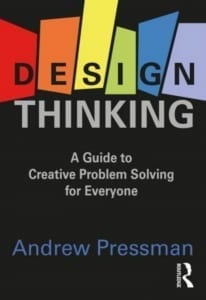Design Thinking: A Guide to Creative Problem Solving for Everyone

1. Business
Design thinking has been recognized as an important means to innovate in the context of developing new products and technologies. But design thinking can also be applied to other business-related challenges such as devising entrepreneurial practice models, expanding professional services, operations, and even setting fees or pricing plans.
There are many cases revealing the value and power of design thinking in the corporate world that have been widely published but are primarily focused on teams—especially managers collaborating with designers. Indeed, many business school curricula incorporate elective and required courses (in addition to specialized tracks) on design thinking. The sample vignettes below, however, show how individuals apply design thinking to a very broad range of problems at varying scales.
Implementing a strategic technology plan
One of the things I so enjoy about my work is that whatever the particular challenge or business problem is, I always take a design approach to developing a solution. One of the most important aspects of that approach is that it enables me to maintain a focus on the “big picture,” or overall vision, even as I’m grappling with the weedy details. When talking to other business owners and entrepreneurs, a common refrain is feeling overwhelmed by all the logistical/management details that have to be attended to, and that can suck the life out of your dream. I certainly have my bad days like everyone else, but having a vision and a high tolerance for ambiguity (which is the same as having a high tolerance for risk) are enormously helpful to me. It puts the tedious details of running a business into a larger context and gives those activities meaning. –Michael Tardif
Michael Tardif has over twenty years of experience applying information technologies to the design, construction, operation, and maintenance of buildings. He currently leads Building Informatics Group based in North Bethesda, MD.
Strategic plan as jigsaw puzzle
Michael had been asked to develop a strategic technology plan to implement Building Information Modeling software in a construction company—complete with itemized tasks and schedule milestones—and then “drive” implementation of the plan. After studying business operations for three months, he realized that rolling out a strategic plan—executing a linear sequence of steps—would fail because it would be so highly invasive and disruptive to existing business operations. Instead, Michael proposed a vision (or design concept)—a set of measurable goals for the company to achieve—and then set out to achieve those goals opportunistically, in a non-linear fashion, without working out the specifics of execution in advance.
To accomplish this daunting undertaking, Michael invented a brilliant metaphor: “strategic plan as a jigsaw puzzle.” Michael sought opportunities on different projects to implement portions of the strategic plan; in other words (invoking the metaphor) putting puzzle pieces into place wherever he could. The process was messy and non-linear. Michael and the staff had to synthesize information as it became available, and make adjustments to the “design solution” while maintaining the vision. But the vision always remained clear, and the “complete picture” of the strategic plan emerged over time. This was fundamentally a design thinking process.
When the process began, Michael knew conceptually what the end result should look like, but didn’t quite know how they would get there. If they had waited to have all the detailed elements in place before starting, they would have never started. And they would have failed, because the details would have been wrong, and would have diverted attention from the overall vision they were trying to achieve.
The puzzle metaphor proved more useful than Michael could have dared to hope for. Conversations about the strategic plan revolved around the question, “What piece of the puzzle is that?” Most importantly, at any point in time, no one cared that the picture was incomplete; staff understood that they were moving toward a complete picture, and understood how they were getting there. Michael could have called the strategic planning a design process instead of a jigsaw puzzle, but that metaphor would have been lost on anyone other than architects.
2. Politics and Society
Design thinking can be a critical tool for addressing leadership challenges. Design thinking promotes visualization of the big picture, reframing of perspectives, creation of innovative solutions to problems, attention to detail, and management and reconciliation of diverse and complex interests and relationships. Cultivating an attitude to authentically listen to insights from others as well successfully sharing one’s own vision may not always be easy but can be very effective as illustrated below.
Expanding the politics of civic engagement
A good leader uses the design process as a model that allows everyone to participate and thus improves and expands the politics of civic engagement.
The most creative and productive way [to apply design thinking] is to engage people—the [stakeholders]—in the process. –Richard Swett (from Leadership by Design by Richard N. Swett with Colleen M. Thornton).
Richard N. Swett was elected to the US Congress and served as the US Ambassador to Denmark.
Dick underscores a fundamental aspect of design thinking that leads to successful resolution of problems or great projects that are rich in meaning: be inclusive. The magic occurs when the input is creatively interpreted, and stakeholders see or are explicitly shown how their ideas influenced the outcome. The stakeholders are then more likely to be fully invested in that outcome, which is so important for success. This creative interpretation may reveal windows of opportunity not previously contemplated, and may thereby provide extraordinary solutions that are also responsive to stakeholder requirements and preferences.
A leader who applies design thinking is someone who has a vision, understands where he or she is going to direct the process, but is not confined by the boundaries or preconceptions of what a solution could be. The design thinking method will allow—even encourage—everyone who is participating in formulating the solution to make their contributions, and the solution will then emerge. It could be a political, business, or some other organizational context where there is a need for leadership, but also there is the likely benefit of participation. The end result is not clearly defined; rather, engagement with the whole process takes the team to a solution.
A caveat worth noting is that this type of leadership requires some assertiveness and presence; a design-by-committee environment can be frightening if the leader does not have the confidence to control the dialogue in that environment.
Dick recommends working toward the best solution for all the stakeholders, perhaps promoting a shared vision of project objectives from the outset. If design thinking is utilized in its truest, purist sense, the end result can sometimes be a surprise. But as long as it is a better surprise than what everybody had in mind, then that’s okay!
Writing and passing the Congressional Accountability Act
Dick co-authored the Congressional Accountability Act, landmark legislation that requires Congress to abide by the same laws it passes for the rest of the country. I asked Dick how he was able to harness inclusive participation in order to get this landmark legislation passed.
The typical process in Congress involved first writing a bill, then seeking cosponsors, and finally the bill goes to the floor of the House of Representatives where people try to pin amendments to it in order to change what they don’t like. Dick suggested, “Why don’t we do this like we’re designing a building: let’s go around with a blank piece of paper to all the different groups that are interested in the accountability, and let’s ask them to tell us how to design this, and we will interpret, integrate, and synthesize their different designs. We will come up with an amalgam of the best of what they have told us.”
Members are not all going to do this in the same room at the same time. The idea was so totally foreign to them that no one really understood what was going on—so much so that Norm Ornstein at one point said, “Wait a minute, you guys are letting everybody say what they think your legislation should be, and then you’re going to come back to them with three different schemes to review, then they’ll pick the one that they like the best?!”
Dick responded, “That’s exactly what we’re going to do.” Ornstein said that this is fascinating because no one has ever taken this approach in this body before.
It took three and a half years to complete the legislation; Dick and his coauthors had to threaten everybody because they weren’t moving the bill to the floor for a vote. Congressional members didn’t want to be made accountable because they had this great House rules system where they could do whatever they pleased—their behavior never had to be connected to the laws that were passed for the rest of the country. Dick and others finally forced the vote; they won 97-3 in the Senate and something like 433-3 in the House. It passed by an overwhelming margin because everyone was participating and yet Dick and his coauthors were still able to give this direction and to maintain a sense of control over what they were ultimately trying to achieve. It was a captivating exercise.
Part of the creativity lies in how Dick was able to interpret the input in a way that was meaningful and effective while everyone felt as though they were invested in its content.
3. Law
Alternatives and the big idea
The notion of alternatives is an extremely valuable part of design thinking.
Stepping back and always asking yourself what’s the big idea—what is the organizing principle to what you’re doing—is a key part of design thinking. –Jay Wickersham
Jay Wickersham is principal of the Cambridge, Massachusetts law firm Noble, Wickersham & Heart LLP. Jay holds both law and architecture degrees from Harvard.
There are several ways that design training has been helpful to Jay. One is the synthesizing of different kinds of information from a whole host of different sources. Design thinking is very powerful in training you to keep looking more broadly; to keep looking beyond the borders of what one might think is the problem. Draw in information and knowledge from all kinds of different sources. In that sense, design training is quite the opposite of legal training. In legal training, you are trained to screen things out, to keep narrowing down, and to make a decision that turns on one or two key legal points, so you can dismiss everything else as irrelevant.
In contrast, design thinking stipulates that you look as broadly as possible, and then find ways to integrate the information you’ve gathered. Related to that point, in architecture you come to respect the perspective and expertise of others. Architects have a unique responsibility to coordinate vast amounts of multidisciplinary input: on any project of modest scale architects might have from ten to thirty or more consultants in other disciplines, any one of whom knows more about their part of the project than the architect does.
And the same thing is true when it comes to the contractor. Any one of those subcontractors and suppliers know more about their particular piece of the building than the architect. So the architect’s challenge is to extract that expertise, weigh it, and figure out how to coordinate that particular piece of information with all the other pieces of information.
An extremely valuable part of design thinking that Jay has learned is the notion of alternatives. Do not fall in love with your idea. You need to generate five more. Jay is always trying to give his clients alternatives, whether it’s figuring out how to resolve a dispute, structuring contracts on a complicated international project, or thinking about an ownership transition. List the pros and cons of each of the alternatives or approaches. Jay, of course, has a sense of which he thinks is favorable, but this should also be a discussion with the client.
If there are several options, the final solution, scheme, or alternative usually borrows elements from each one. Jay states that, in his law firm, they don’t pretend to have the “right” answer. Whenever possible, they present alternative approaches as a way of eliciting the discussion, which usually results in coming up with an answer that will be probably better than any of the alternatives. And it will get people on board to support it.
Jay believes that if you give people the sense of different options, they don’t feel like they’re being railroaded into doing just one thing. They are much more receptive to having an open conversation about the pros and cons. If you feel strongly about one option, it is often easier to convince somebody if you’ve been able to show why one approach is not as strong as another.
Here is another way that design thinking is so important to Jay: the way in which the process is iterative. This is central to design thinking. The process starts at the conceptual level—and this applies to the alternatives as well—but keeps narrowing in. When Jay is putting together contracts or some legal agreement, he’ll make the analogy that they don’t want to jump into construction documents before they’ve done the concept design—and the client is asking him to move right into construction documents. The concept design must be completed first, then fleshed-out in the next phase, and then they can move into the actual agreement.
There’s a real risk, particularly when someone has an expertise (i.e., a lawyer), that a client assumes you’re going to move directly into the final product. In design thinking you start conceptually and then flesh it out, develop more detail, and then, as you move into a larger scale, you are forced to tackle a whole new set of issues. Note that always, through all iterations and scales, you must try to maintain a kind of integrity to the design or big idea. That’s a wonderful model for a process and end result.
About the Author














Leave a Reply
Want to join the discussion?Feel free to contribute!